Bot Platform: Facebook Messenger
Considering how bots play into the big picture for MessengerFacebook has BIG plans for their Messenger product. Most relevant to the bots living and working in Messenger, Facebook’s priorities include:
- Create or enable differentiated services that improve over time (i.e. bots)
- Drive more ad revenue
- Improve the customer support experience
Facebook’s Plans for Messenger
Facebook announced that their Messenger product would support bots at their F8 conference in April 2016. At the conference, they laid out their 10-year plan for the company:
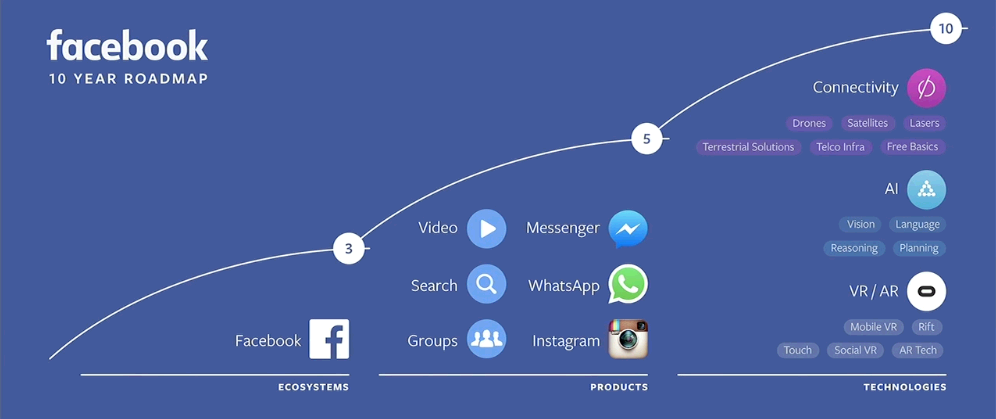
This view sets Messenger up as a stepping-stone on the way to AI (language, reasoning, planning, etc). But it’s also a (necessarily) superficial view. At this high of a level of abstraction, getting from Messenger to Lasers seems like a huge jump.
But this strategy didn’t spring out of nowhere, and lots of thinking has gone into the connective tissue between these services. It’s just an evolution of the strategy that Facebook has articulated previously.
Here is a look at the product roadmap for Facebook Messenger circa 2015:

Facebook is definitely looking at Messenger as a single interface that enables lots of different interactions. In this article, we’ll focus on those use cases that keep us closest to the world of bots.
First, we’ll focus on the primary use case of Facebook Messenger as a platform for bots that describe differentiated services that improve over time.
Next, we’ll talk about how Facebook is using bots and Messenger to drive more ad revenue.
Finally, placed innocuously down in the lower right corner is “Businesses on Messenger”, and that seems to be a major area of focus for Facebook. And this is the final area we’ll consider.
Create Differentiated Experience That Improve Over Time
Facebook announced that Messenger would be a platform for bots at their F8 conference in April 2016. Other platforms supported bots earlier (Telegram, Kik, Slack) and others announced later (Microsoft, Google). But the Facebook announcement was seen as a major validation of bots as an industry, and it created much of the momentum that the industry still coasts on:
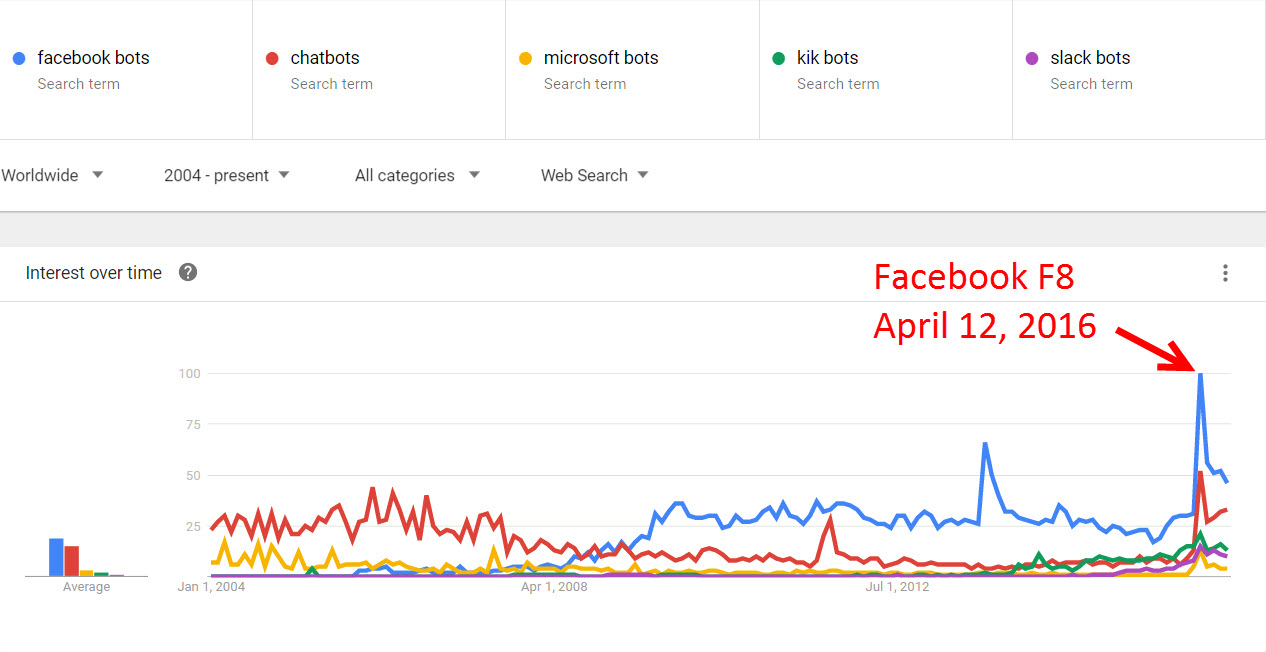
The announcement also laid out why Facebook thinks that Messenger is so important. Facebook thinks the future of consumers interacting with brands is conversation:
“To me it’s about bringing back all the best parts of the interaction between people and businesses,” David Marcus, vice president of messaging products at Facebook, says in an interview. “What we’re trying to build with bots are rich conversational experiences. That’s what we believe will be the future of interactions and services.”
From the product roadmap slides above, it’s clear that Facebook has a long view of the space, and they’re making a clear bet on conversational interactions. The first of these interactions will take place via text through Messenger.
Some people have said that the early versions of these bots suck. Many of them do – they’re just not that compelling from a user experience perspective.
The first caveat here is that the bot industry is still in its infancy. The foundational technology and interaction models are both being built as we speak.
The second caveat is that people aren’t used interacting with services that are dependent on machine learning (ML). In many areas of consumer technology, the expectation is that software is launched when it has been fully developed and debugged, and is ready to “go to market”.
ML software is different by nature. Better machine learning software depends on better data. The strategic advantage for ML software is huge amounts of data gathered from real users, which are used to train your ML models, and improve your software. As a result, ML software like bots needs to be launched early/ugly.
Facebook has made several announcements about the growth of bots on Messenger – claiming “over 11,000 bots” in July 2016, and “over 33,000 bots” in September 2016. Of course, it’s hard to verify any of these claims, and even harder to understand what the *actual numbers* are. No one is sharing numbers around how many people are using their bot, what the usage patterns look like, etc.
The best we can do is try to understand the market by seeing what areas people are developing bots for. Botlist and Chatbottle both created directory-style lists of active bots. The total numbers are much smaller (e.g. 199 Messenger bots listed in Chatbottle). So this is obviously a small sample. I ran a scraper against these directories, and then pulled out how many times each Category of bot was mentioned. Some belonged to only 1 category, some belonged to several.
What interests me here is what kinds of bots people are building:

And here’s a view from Botlist:
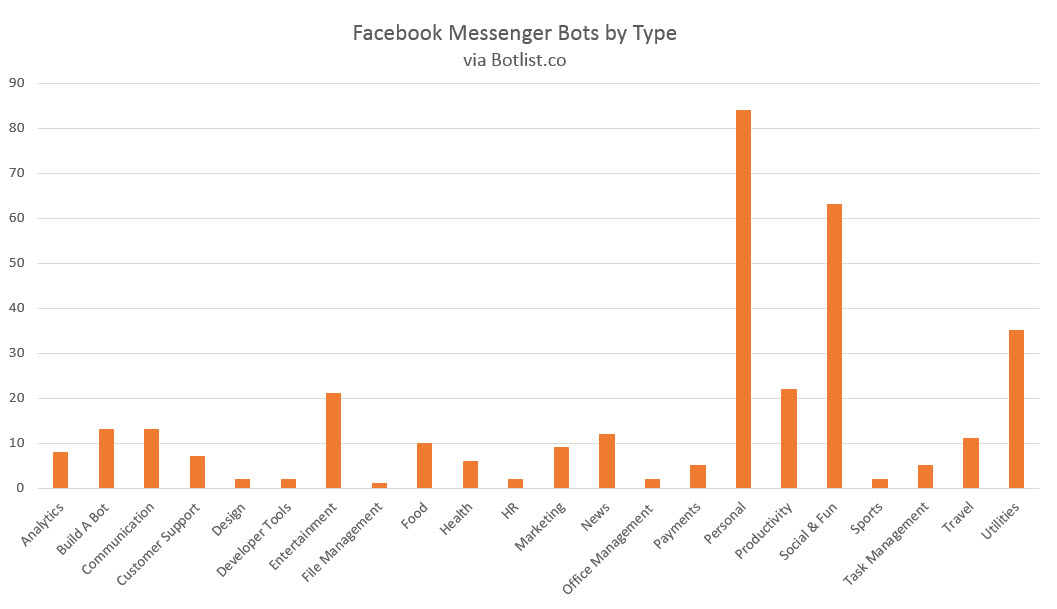
I don’t find it surprising that “casual / fun” categories rise to the top (e.g. Personal, Social & Fun, Entertainment, etc). There are some real surprises in where people *aren’t* developing bots (Travel and Sports in particular seem shockingly under-represented).
Drive More Ad Revenue
Facebook earns its money based on ad revenue – about $18B in 2015. No matter how many other services Facebook may be developing, there will always be an eye to how new products can add value to Facebook’s core advertising business.
In early September 2016, Facebook added the ability to create Facebook ads that drive to your bot. This may seem like a small thing, but it’s significant in terms of solving the bot discoverability problem. Simply – how do you get people to know that your bot exists?
Well, conveniently, one way is buying Facebook Ads! Advertisers can now select Messenger as a destination for their ads. Clicking opens up Messenger with a customizable structured message:
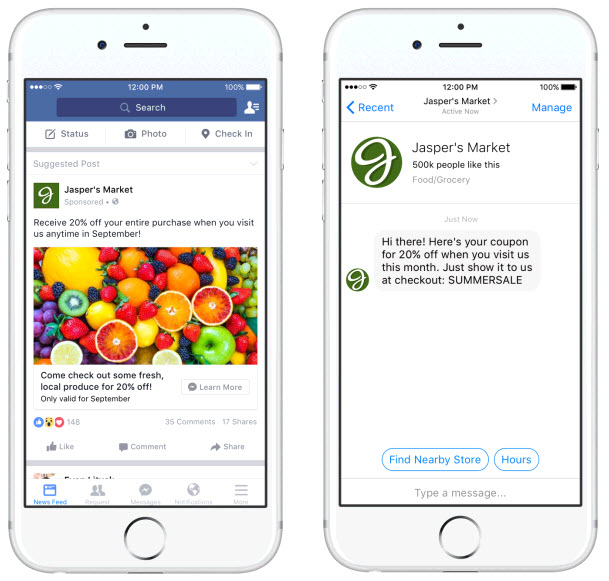
So, this functionality will earn ad revenue for Facebook, and will help with the discoverability problem for bot developers. What else does this change?
This is (in my opinion) a MASSIVE change for bot developers in terms of product development and customer development.
The “cold start” problem of a bot with few or zero users can now be solved with a credit card.
How can you learn what features and functionality users prefer if you don’t have any users? Similarly, how can you begin to understand what it takes to retain users and increase customer lifetime value if you don’t have a steady stream of new customers to analyze in cohorts as you refine functionality?
The cold start problem is especially problematic for applications like bots that use machine learning. Product improvement requires LOTS and LOTS of data for the systems to build models and learn from. No users, no data, no machine learning improvements.
This new ad product has now put the data required for successful product development, customer development, and machine learning improvement in the hands of any organization with a deep enough pocketbook. Lots of venture capital dollars will be burned in this fire, but it’s all gravy as far as Facebook is concerned.
In November of 2016, Facebook opened up Sponsored Messages to all advertisers. This allows any advertiser to send messages to anyone who’s previously been in contact with them via Messenger.
When we first wrote about sponsored messages in Messenger in April of this year, we noted the risk of them feeling spammy, especially in an environment where you usually only get messages from people you want to hear from (usually…). Sponsored messages could feel like they are breaking that experience by arriving to you unsolicited.
In July 2017, Facebook announced the global rollout of Messenger Ads. Apparently, Facebook didn’t see any bad user data that scared them off from this monetization channel. Eventually, every channel that can carry an ad will.
Improve the Customer Support Experience (or Swallow it Entirely)
Facebook is looking to provide tools that more deeply enmesh businesses with their platform. Messenger is where they’re making some of their biggest bets in this area.
One of their first moves was to get customer-to-business communication off of Fan pages, and into its own channel – Messenger.
Social media is where people go to air all kinds of grievances about their experiences with all kinds of companies. A common fear of businesses that are slow to adopt social media is that their social channels will become never-ending laundry lists of complaints, and damage their brand.
Other companies have social media channels, and customers attempt to interact with them there, but don’t get anywhere.
Facebook has correctly recognized that there’s a yawning chasm between how people would like to interact with brands around customer support, and the channels currently available to them:
- 67% of customers have used Facebook for customer service
- That adds up to 2.5B public comments on business pages each month
- 87% of posts to these business pages go unanswered.
- Of those companies that DID respond to posts, only 10.5% responded to every post
So, we see a potential problem. People are using Facebook to reach out to companies, the companies aren’t prepared to service requests via social media. The end result is a bad UX for both customers and companies. Surely there has to be a better way? Enter Messenger.
David Marcus, the head of Facebook Messenger, has said in the past that he thinks touch-tone phone customer support is primed for disruption. Businesses can save on expensive call center employees that only handle one query at a time by using instant messaging support staff that can simultaneously handle multiple angry customers.
To get a feel for why this is a smart move (both for individual companies and for Facebook) it’s instructive to think about the call center market as a whole.
First off, the call center and customer support market is BIG – with revenue of $18 billion annually in the United States in 2013. That revenue has been declining, largely due to outsourcing. And the companies that have to pay for expensive call center employees would love to see it decline even more. Facebook would love to see a big portion of that spend diverted into Messenger:
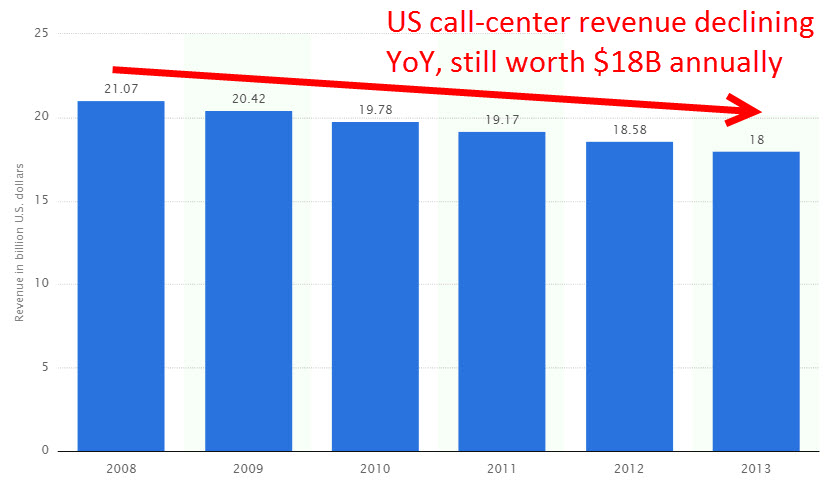
- “This is the 18th year since Dimension Data started publishing the Global Contact Centre Benchmarking Report and it marks the most important industry change we’ve seen in the last 30 years: the growing irrelevance of the telephone-centric model.“
- Web-based interactions are going to overtake phone-based interactions in 2016/2017
- The majority of people under 40 would rather use social media and web chat than talk on the phone to customer service
- 56% of people overall say they’re happy to use virtual assistants when contacting brands
- Each call to a call center costs $10
So the market is clearly moving in this direction, traditional call centers staffed by humans are expensive, and FB is more than happy to use its ubiquity and scale to create these tools that enable better customer service interactions. Customer support is a huge business.
Of course, the tie-in with bots is automation. Automation can provide even cheaper customer service:
With saved responses, five-minute calls could turn into 15 second re-sendings of pre-made support answers. And Facebook is already working the Businesses On Messenger partners to let them use artificial intelligence systems to automate some of that response process, so humans only step in when the AI gets confused.
The cost savings for replacing customer service reps could be substantial – up to 30% of total salary expenditure for the category, totaling over $23 billion dollars. That’s a lot.
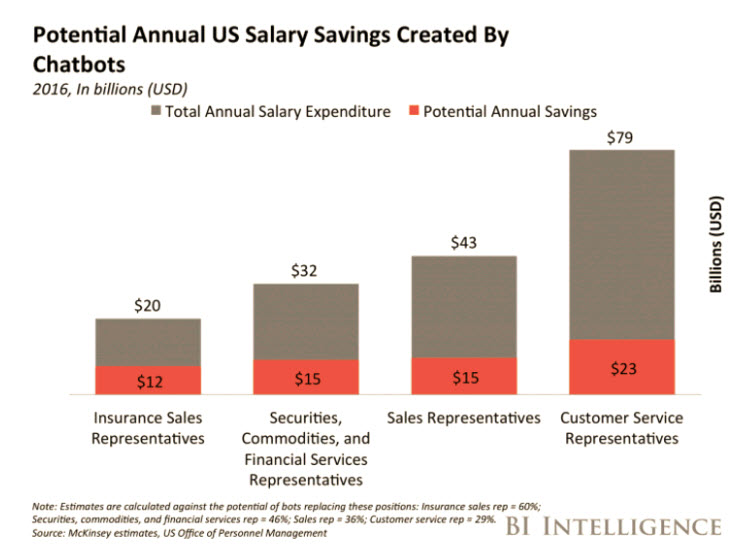
But cost savings is just one benefit. If Facebook can enable better communication between companies and their customers (which are already on Facebook), then they can use their technology platform as way to bring more businesses onto Facebook.
So your receipts, all of your customer service interactions, your shipping notifications. All of these things should stay because they might be helpful for you in the future.
So it’s clear that Facebook is building out customer service functionality within Messenger as a way to enmesh businesses. If you’re the primary mechanism of contact between a business and its customers, and you can provide all kinds of data analysis services that increase the strategic value of the data that’s in the system, you’re in a pretty powerful position.
Maybe you offer businesses an “Enterprise Customer Service” package. Or maybe you just use the lock-in to sell even more advertising products to companies:
Not only could absorbing formerly clumsy customer-to-business communication drive platform lock-in, it could give Facebook valuable insight into commerce. The more Facebook knows about what you buy and what businesses you interact with, the better it can target its ads and tune its News Feed content.
As with most machine-learning companies, Facebook is looking to build more and more data around users in aggregate, and how they behave, so that they can more effectively target advertising to them. And the data around which brands you as a consumer interact with, and what your interactions are like, may be some of the most valuable commerce-related data available.
